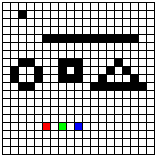|
"At Sony, we assume all products of our competitors will have basically the same technology, price, performance, and features. Design is the only thing
that differentiates one product from another in the marketplace." |
Graphic Design
Graphic Design is a profession that pertains to (among many others) typography, use of color, 2D & 3D spatial organization and temporal sequencing. The function of designers is to solve problems of communicating products, concepts, images, and organizations in the most original and precise form [2].
Visual or graphic designers working on Web project are forced to design in a grid environment from the outset, because of the nature of computer screens, which are a
combination of red, green and blue light-emmitting squares called pixels.
 Any icon or graphic element used on the Web is saved as either a GIF or
JPEG image. These images are a combination of square pixels. Pixels are combined to form design elements such as dots, lines and circles.
Any icon or graphic element used on the Web is saved as either a GIF or
JPEG image. These images are a combination of square pixels. Pixels are combined to form design elements such as dots, lines and circles.
Adrian Frutiger, one of the great type designers of the 20th century, has outlined the design elements needed to create signs in his masterpiece Signs and Symbols. Included in this list are the dot, line and its variations (oblique, curve, horizontal, vertical), what he terms the morphology of signs or symmetry and asymmetry. He also provides information about the basics of signs which include the square, the triangle, the circle, the arrow and the cross. These traditional elements and basics enumerated by Frutiger are translated to pixels by digital graphic artists, so consequently understanding the principles of design helps artists to develop better work in the digital world.
Psychology of Art
Rudolf Arnheim offers up the theory that humans fundamentally think visually. He has made seminal contributions to the psychology of art, aesthetics, art education, and media studies. He has advanced a psychological approach to aesthetics. Arnheim in Visual Thinking suggests that thought and perception are intertwined. He states that "the three terms picture, symbol, sign do not stand for kinds of images. They describe three functions fulfilled by images." [3] Understanding that icons on the Web perform different functions is key to using them properly. Arnheim offers the following suggestions for how images function:
sign
- image serves as a sign to the extent to which it stands for a particular content without reflecting its characteristics visually.symbols - an image acts as a symbol to the extent to which it portrays things which are at a higher level of abstractness than is the symbol itself.
pictures - images are pictures to the extent to which they portray things located at a lower level of abstractness than they are themselves. [4]
Paul Messaris, in his book Visual Literacy, state that "pictures have no explicit means of
expressing affirmation. What we are dealing with here is the more general principle that pictures lack a systematic set of symbols and syntactic devices for making propositions."[5]
Whether one considers a sign, symbol or picture, none have inherent characteristics that make them understandable to an individual. His discussion suggests that individuals are not
born with visual literacy, but instead it is a learned skill that requires abstract understanding. When anticipating a user's interaction with a Web site, the design professional must take into
account the idea that users are not inherently born with visual literacy, but acquire it over time through education.
![]() Sources:
Sources:
- Peters, Tom. Design Management Journal, Design Is It!, Summer 1998, pg. 20
- Swann, Alan. How to understand and use Design and Layout, pg. 6
- Rudolf, Arnheim. Visual Thinking, pg. 136
- Ibid, pg. 136-138
- Messaris, Paul. Visual Literacy, pg. 115